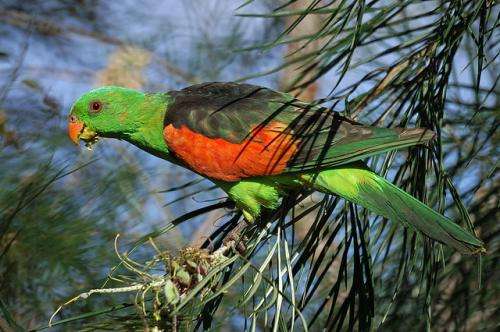A red-winged Parrot (Aprosmictus erythropterus). Credit: David Cook
Wildlife smugglers within and outside Australia could be exploiting high overseas demand for Australian parrots due to a lack of systematic reporting and monitoring of the wildlife trade in many countries, according to a UWA study.
Study author Bin Weng Low, a member of the South-east Asian Biodiversity Society, found Singapore was a transit hub for exotic wildlife trade, with nearly 20,000 Australian parrots (27 species and two sub-species) legally imported into the country from 2005–2011.
Of these, almost 11,000 were then exported, accounting for 10 per cent of all Singapore's reported bird trade. The major consumer markets are in Taiwan and the United Arab Emirates.
Australia has a blanket export ban on all Australian parrots, and Mr Low says it's important to note the figures relate to the legal trade of captive-bred Australian parrots from countries such as South Africa and the Netherlands.
Mr Low's study focused on the 54 species of Australia parrot listed in the Convention on International Trade in Endangered Species of Wild Fauna and Flora (CITES), an international agreement to ensure trade in wild animals and plants does not threaten their survival. CITES works by controlling the trade volumes of the species it lists.
"There are presently 180 countries that have signed the agreement, including Australia," Mr Low says.
"One of the obligations is that each country must maintain trade records of CITES-listed species…and submit them yearly to the secretariat."
Mr Low says the biggest concern is the significant variation in countries' ability and commitment to monitoring and reporting wildlife trade.
"Consequently, it's very difficult to ascertain if reported figures are an accurate reflection of actual trade volumes."
Given this concern, Mr Low says there is no silver bullet solution.
"Wildlife smugglers would be able to exploit the lack of systematic reporting by smuggling live birds and eggs through their connections to overseas dealers, who can then 're-export' the parrots through the legal system by labelling them as captive-bred," he says.
"The CITES management authority of individual countries may not be stringent in verifying the source of the birds found in aviculture facilities, [so] it's plausible some exotic parrots found in any particular breeding farm could have been smuggled from their native countries.
"The onus is ultimately on the governments of each of the CITES member countries to ensure their data reporting and monitoring is as accurate as possible," he says.
More information: "The global trade in native Australian parrots through Singapore between 2005 and 2011: a summary of trends and dynamics." Emu 114(3) 277-282 dx.doi.org/10.1071/MU13094
Provided by Science Network WA
























